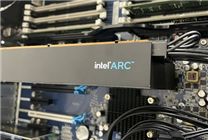Key Highlights:
- Intel’s Ruixuan A750 graphics card unexpectedly revealed a development sample with unique specifications.
- This model features a remarkable 512-bit width and 16GB GDDR6 video memory.
- Comparison with existing models reveals potential shifts in Intel’s graphics strategy.
On September 15, exciting developments emerged regarding Intel’s graphics technology, particularly with the Ruixuan A750 model. While anticipation builds for the second-generation Ruixuan B7 series, a notable first-generation product has surfaced, raising eyebrows in the tech community.
Development Sample of Ruixuan A750
This newly revealed sample, sourced from Blue Ridge, is not just any typical card; it showcases a significant upgrade in specifications that sets it apart from its predecessors. The Ruixuan A750 is equipped with an extraordinary 512-bit width and a substantial 16GB of GDDR6 video memory, marking a stark contrast to the standard offerings in this series. Conventional models in the Ruixuan lineup, such as the A750, typically include only 8GB of video memory operating at a 256-bit width.
This revelation, confirmed through the graphics card’s label and system detection information, suggests that Intel may have ambitious plans for its high-end graphics solutions. The increased memory bandwidth and capacity could indicate a push towards enhancing graphics performance in demanding applications.
Intel’s Graphics Card Evolution
Historically, Intel has not ventured into the realm of 512-bit wide discrete graphics cards. The highest-performing A770 model currently includes 16GB of memory but remains at a 256-bit width. This discrepancy raises questions about the strategic direction Intel is considering for its graphics division.
It is plausible that Intel initially envisioned the 512-bit specification for the A750 but subsequently assessed market conditions and potential returns, deciding against full-scale production. The performance of graphics cards is closely tied to memory bandwidth, and this specimen could signify Intel’s exploration of higher-tier capabilities.
Power Specifications and Future Prospects
The A750 sample comes with an 8+8-pin auxiliary power supply interface, slightly more robust than the 8+6 configuration of the official public version. This enhancement in power supply requirements hints at the card’s potential for higher performance levels and greater overclocking capability, appealing to enthusiasts who seek cutting-edge gaming and rendering performance.
With these revelations, anticipation grows for the upcoming Ruixuan B7 series. Tech enthusiasts are eager to see how Intel will leverage these insights to solidify its presence in the competitive graphics market against established leaders.
A Closer Look at Future Releases
In conclusion, the unexpected insights from the Ruixuan A750 development sample not only spotlight Intel’s ongoing efforts in the graphics space but also set the stage for potential breakthroughs with the forthcoming Ruixuan B7 series. The industry should stay vigilant, as Intel appears poised to make significant strides in delivering superior graphics performance in the near future.





